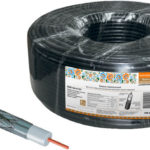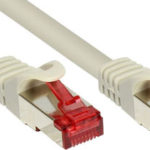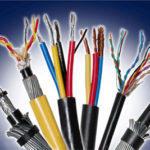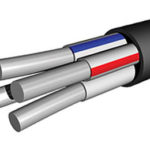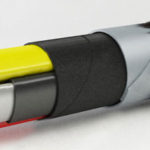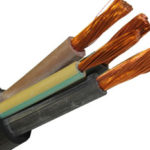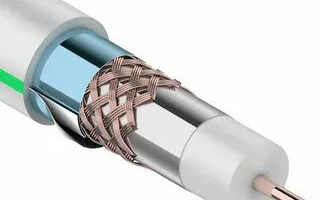Hardly a person who has never seen a coaxial cable. How it is designed, what are its advantages, what are its applications - this is still a lot for many to figure out.
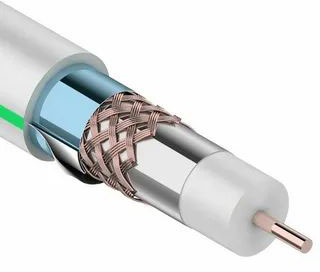
Contents
How is the coaxial cable constructed?
A coaxial cable consists of:
- inner conductor (central core);
- dielectric;
- External conductor (braid);
- The outer covering.
If you look at the cable in a cross-section, you can see that both of its conductors are on the same axis. Hence the name of the cable: coaxial in English.
The inner conductor in a good cable is made of copper. Nowadays, cheap products use aluminum or even copper-plated steel. The dielectric in high-quality cable is polyethylene, and in high-frequency cables - fluoroplastic. Various foamed plastics are used in inexpensive versions.
The classic material for braiding is copper, and the braiding of high-quality products is made with a dense weave, without gaps. In lower-quality cables for the manufacture of the outer conductor are used copper alloys, sometimes steel alloys, to make it cheaper a rare braiding is used, in some cases - foil.

Field of application of coaxial cable, its pros and cons
The most common use of coaxial cable for transmission of high frequency currents (RF, microwave and above). In many cases, so carry out link between the antenna and the transmitter or between an antenna and a receiver, as well as in cable TV systems. Such a signal can also be transmitted using a two-wire line - it is cheaper.

In some cases this is done, but such a line has a serious disadvantage - the electric field in it passes through the open space, and if it gets caught by a foreign conductive object, it will cause distortion of the signal - attenuation, reflection, etc. But in coaxial cable the electric field is completely inside, so when you lay it you don't have to worry that the line will pass metal objects (or they may later be in close proximity to the cable) - they will not affect the performance of the transmission line.
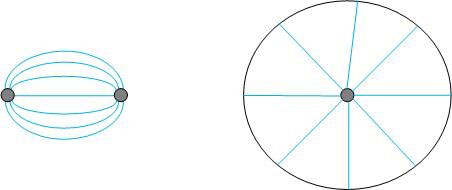
The disadvantages of coaxial cable include its high cost. Also the disadvantage is considered a high labor intensity of repair of the damaged line.
Previously, coaxial cables were widely used for the organization of data transmission lines in computer networks. Today, transmission speeds have increased to levels that radio-frequency cable cannot provide, so this application is rapidly being phased out.
The difference between coaxial cable and armored cable and shielded wire
Coaxial cable is often confused with shielded wire and even with armored power cable. While there is some external similarity in design ("core-insulation-metal flexible jacket") their purpose and principle of operation are different.
Coaxial cable braid acts as a second conductor that closes the circuit. It necessarily carries a load current (sometimes even the inner and outer sides are different). The braid may or may not have contact with ground for safety purposes - this does not affect its operation. It is also incorrect to call it a shield - it does not have the shielding function globally.
Armored cable has an outer metal braid that protects the insulation layer and the core from mechanical effects. It has a high strength, and it is always grounded according to safety requirements. In normal operation, current does not flow through it.
A shielded wire has an outer conductive jacket to protect the conductor from external interference. If it is necessary to protect against LF interference (up to 1 MHz), the shield is only grounded on one side of the wire. For interference above 1 MHz, the screen serves as a good antenna, so it is grounded all the way through at several points (as often as possible). During normal operation, current should not flow through the shield either.
Technical parameters of coaxial cable
One of the main parameters to pay attention to when selecting a cable is its wave impedance. Although this parameter is measured in ohms, it cannot be measured with an ordinary ohmmeter tester, and it does not depend on the length of the cable segment.
Wave impedance of the line is determined by the ratio of its linear inductance to linear capacitance, which, in turn, depends on the ratio of diameters of the central core and braid, as well as on the properties of the dielectric. Therefore, in the absence of instruments, you can "measure" the wave resistance with a caliper - you need to find the diameter of the core d and braid D, and substitute the values in the formula.

Here also:
- Z - Required wave impedance;
- Er - dielectric permittivity of dielectric (for polyethylene we can take 2,5, and for foam material - 1,5).
The resistance of the cable can be anything with reasonable dimensions, but standard products are available with values:
- 50 Ohms;
- 75 Ohm;
- 120 Ohm (rather rare variant).
It cannot be said that a 75 ohm cable is better than a 50 ohm cable (or vice versa). Each must be applied in its place - the wave impedance of the transmitter output Zи, line of communication (cable) Z and load must be the same Zнonly in this case the transfer of energy from source to load will occur without losses and reflections.
There are certain practical limitations on the manufacture of cables with high wave impedance. A cable of 200 ohms or more must have a very thin core or a large diameter outer conductor (to maintain a large D/d ratio). Such a product is more difficult to use, so either two-wire lines or terminating devices are used for high impedance paths.
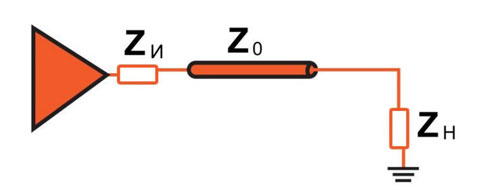
Another important coaxial parameter is attenuation .. It is measured in dB/m. In general, the thicker the cable (more precisely, the larger the diameter of the central core), the less it attenuates the signal with each meter of length. But this parameter is also affected by the materials from which the communication line is made. Ohmic losses are determined by the material of the central core and the braid. Dielectric losses also contribute. These losses increase with signal frequency, special insulating materials (fluoroplastic, etc.) are used to reduce them. Foamed dielectrics used in inexpensive cables contribute to increased attenuation.
Another important characteristic of a coaxial cable is shrinkage factor. This parameter is needed where it is necessary to know the cable length in wavelengths of the transmitted signal (for example, in impedance transformers). The electrical length and the physical length of the cable do not coincide because the speed of light in a vacuum is greater than the speed of light in the cable dielectric. For a cable with a polyethylene dielectric, Kentrenchment=0.66, for fluoroplastic - 0.86. For cheap products with foam insulator - unpredictable, but closer to 0,9. In foreign technical literature, the value of the deceleration factor - Kretardation=1/Кreproach.
Coaxial cable also has other characteristics - the minimum bend radius (depends mainly on the outside diameter), electrical strength of the insulator, etc. They, too, are sometimes necessary for choosing a coaxial cable.
Coaxial cables marking
Products of domestic production had a digital-letter marking (it can be found even now). A cable was marked with letters RK (radio-frequency cable), then there were numbers indicating:
- wave impedance;
- cable thickness in mm;
- part number.
For example, cable RK-75-4 designated products with a wave resistance of 75 ohms and a diameter of 4 mm in the insulation.
The international designation also begins with two letters:
- RG-radio-frequency cable;
- DG-cable for digital networks;
- SAT, DJ - for satellite broadcasting networks (high-frequency cable).
Then comes the number, which does not obviously carry technical information (to decipher it, you have to look into the cable data sheet). Further there may be more letters which mean additional properties. An example of the designation - RG8U - RF cable 50 Ohm with a reduced diameter of the central core and a reduced density of the braid.
By understanding the differences between coaxial cable and other cable products and learning the influence of its parameters on performance characteristics, you can successfully apply this product in the areas for which it is intended.
Related articles:
